|
|
|
| Question 1.1 | |
Approximately what share of the time you spent on this project
did you need to get familiar with the SalesPoint
framework and your specific development environment (percentage)?
| | |
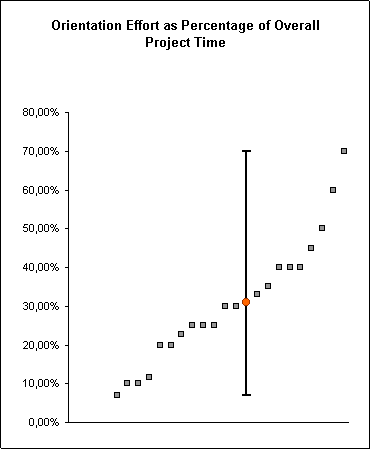 Abbildung 1.1
Abbildung 1.1:
Orientation Effort (Percentage)
| Question 1.2 | |
Evaluate the following sources of documentation for the
framework considering their helpfulness and the frequency
you consulted them.
| | |
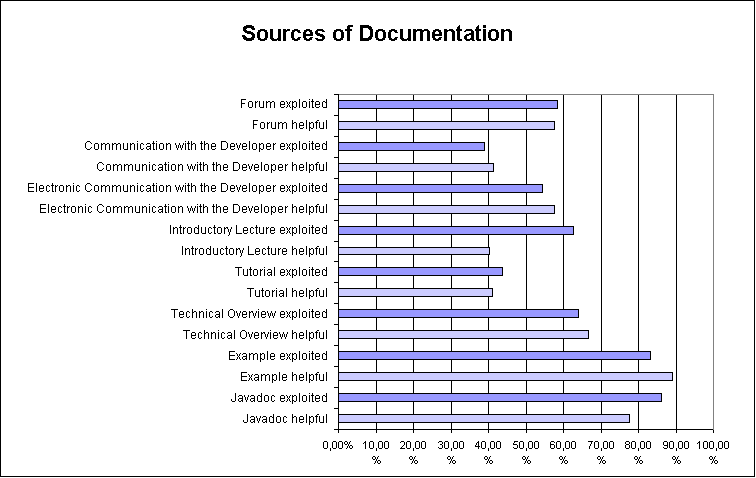 Abbildung 1.2
Abbildung 1.2:
Sources of Documentation
| Question 1.3 | |
What share of the overall project time did you spent
on the individual development phases (weeks, 12 total)?
| | |
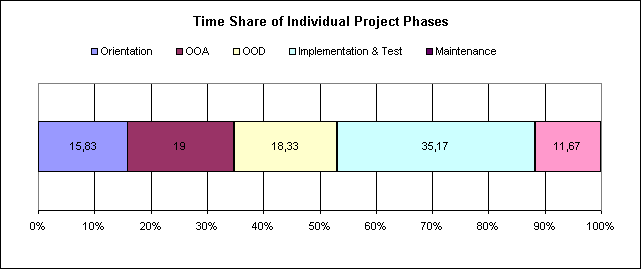 Abbildung 1.3
Abbildung 1.3:
Time Distribution throughout the Project
| Question 1.4 | |
Did the individual development phases separate clearly?
| | Yes: 24% |
| Question 1.5 | |
How many development cycles did you traverse until
producing your final release?
| | Average: 4.04 |
| Question 1.6 | |
On average, how many hours per week did a member of your team
invest into the project?
| | |
| | |
- for team meetings
- for his/her own assigned tasks
| |
Average: 3.20
Average: 9.27
|
| Question 1.7 | |
Was the effort required by the project distributed evenly
throughout the semester?
| | Yes: 8% |
| | |
If not, why?
| | |
| | |
- complex implementation phase (21 times)
- high orientation effort (1 times)
- hard to find a team (1 times)
- communication deficits (1 times)
- other problems (4 times)
| | |
| Question 1.8 | |
Were the contributions by the individual team members to this
project comparable?
| | Yes: 45.83% |
|
|
|
|
|
| Question 2.1 | |
Try to evaluate the result of your project.
| | |
| | |
In most cases, the project specification was met "with
minor reductions". (Average: 2.6)
Evaluation of partial results:
1 ... excellent
2 ... good
3 ... satisfying
4 ... sufficient
5 ... insufficient
| | |
 Abbildung 2.1
Abbildung 2.1:
Qualtity of Partial Results
| Question 2.2 | |
Determine the following metrics describing the complexity
of your application. Include only those classes developed
by your team.
| | |
| | |
-
Number of Non-Comment Lines of Java Code (LOC)
- Number of Classes
- Complexity of your Classes
- Number of Methods per Class
- LOC per Class
- Inheritance Hierarchy
- Maximum Depth
- Maximum Breadth
| |
Average: 5173.30
Average: 47.36
Average: 5.19
Average: 24.41
Average: 1.05
Average: 201.52
Average: 565.45
Average: 11.1
Average: 2.41
Average: 6.33
|
|
|
|
|
|
| Question 3.1 | |
Try to evaluate your team work.
| | |
| | |
In the end, the teams have judged their team work as
"satisfactory" (average - the evaluations reached from
"excellent" all the way to "poor").
| | |
| Question 3.2 | |
How many members was your team comprised of at the time of
| | |
| | |
- signing up?
- submitting the software product?
| |
Average: 5.16
Average: 4.8
|
| | | | |
(-6.98%)
|
| | |
What are the reasons for differences?
| | |
| | |
- dropping the course (3 times)
- change of major/exmatriculation (3 times)
- failing the qualifying exam (1 times)
- joining of groups/late joins (2 times)
- unreliability (1 times)
| | |
| | |
The following questions and their respective answers
are summarized in the chart below. The figures show
the percentage of groups having given a postive
answer "yes".
| | |
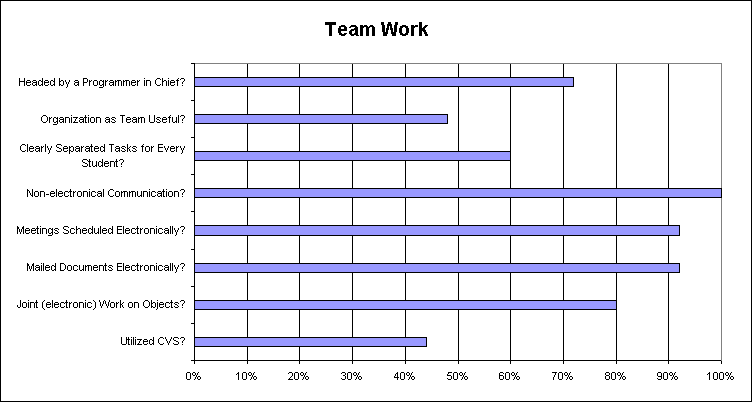 Abbildung 3.1
Abbildung 3.1:
Evaluation of the Team Work
| Question 3.6 | |
How did you pursue the development of your software?
Briefly enumerate its characteristics (development in the
computer lab of the department or at home, setup of a
designated server or group account, your version management,
...)
| | |
| | |
-
Where?
- department lab (13 times)
- at home (21 times)
- with CVS (9 times)
-
without CVS or with own version management (10 times)
-
How?
- designated group account (6 times)
- designated mailing list (5 times)
- private FTP server (2 times)
- others (13 times)
-
Problems?
- with WinCVS/jCVS/CVS (5 times)
- with framework (3 times)
- with software tools, e.g. Together (3 times)
- with hardware (1 times)
- with Java (5 times)
- with communication (5 times)
- with group account/permissions (2 times)
- others (1 times)
| | |
| Question 3.8 | |
If you did not apply CVS, why not?
| | |
| | |
- avoided additional effort to get familiar with CVS (8 times)
- chose a different version management (2 times)
- CVS was not necessary (4 times)
| | |
| | |
If you applied CVS, what were your experiences?
| | |
| | |
-
it is possible to have several people working on the same file
(1 times)
- satisfying (6 times)
- synchronization of different versions possible (4 times)
- others (2 times)
| | |
|
|
|
|
|
| Question 4.1 | |
Evaluate the SWT project as academic course!
(see the chart; 1 ... applies, 5 ... does not apply)
| | |
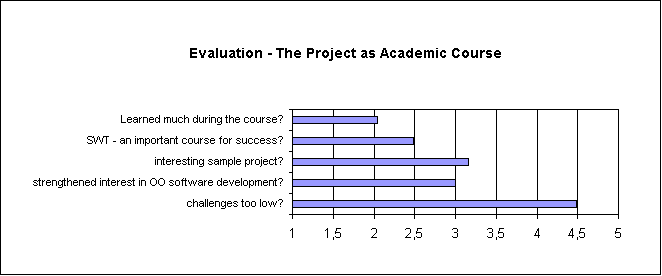 Abbildung 4.1
Abbildung 4.1:
Evaluation of the SWT Project as Academic Course
| Question 4.3 | |
On which platform did you pursue your development?
| | |
| | |
-
Operating System:
- Linux/Unix (12 times)
- Solaris (3 times)
- Win95+/NT (22 times)
-
Java Development Environment:
- JBuilder4 (12 times)
- Together4 (2 times)
- Forte (6 times)
- JDK 1.3 (6 times)
- (x)emacs (1 times)
- Windows text editors (1 times)
- Ultra-Edit (1 times)
- others (9 times)
-
CASE Tool:
- Together4 (19 times)
- Forte (1 times)
- (x)emacs (1 times)
- others (3 times)
-
Text Processing Tool:
- JBuilder4 (2 times)
- Together4 (1 times)
- (x)emacs (5 times)
- Windows text editors (13 times)
- Ultra-Edit (4 times)
- web site tools (1 times)
- others (19 times)
-
Project Management Tools:
- Together4 (2 times)
- (x)emacs (5 times)
- CVS/WinCVS/jCVS (8 times)
- eMail (1 times)
- ICQ (1 times)
- web site tools, homepage (1 times)
- others (4 times)
-
Other Tools:
- javadoc
- java2html
- sourcelet
- make
| | |
|
|





